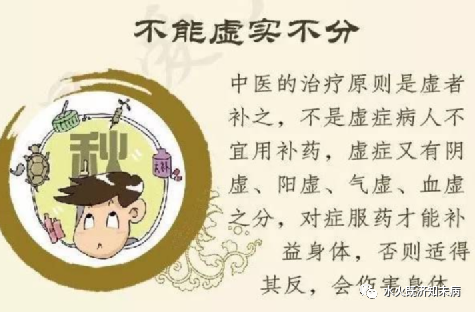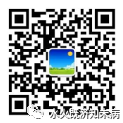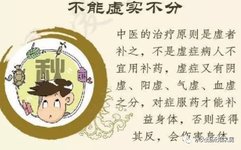
Xu (虚) and Shi (实) refer to the nature of pathological changes and are extremely important in diagnosis (辨证) within Traditional Chinese Medicine (TCM). Therefore, when there is Xu, we supplement; when there is Shi, we drain. This is a fundamental principle of treatment. Supplementing leads to Shi, and draining leads to Xu, which are the inevitable results of accurate diagnosis and treatment. However, understanding the Xu and Shi of pathological changes and treatment methods can be quite challenging. Analyzing the Xu and Shi during diagnosis has multiple meanings that should not be confused, as this would affect the accuracy of the diagnosis. Upon detailed analysis, there are several meanings:One, the division of Xu and Shi based on the strength of Zheng Qi (正气)《伤寒论·平脉法》 states: “When the pulse comes quickly and leaves slowly, it is called Nei Xu (内虚) and Wai Shi (外实). When the pulse comes slowly and leaves quickly, it is called Nei Shi (内实) and Wai Xu (外虚).”According to Zhou Chengzhi in the Commentary on the Pulse Diagnosis, it explains: “The coming and going refers to the pulse’s entry and exit; entry and exit refer to the internal and external aspects of Yin, Yang, blood, and Qi. Quick coming and slow leaving indicates more Qi is exiting than entering, hence Wai Shi; slow coming and quick leaving indicates more Qi is entering than exiting, hence Nei Shi. Wai Shi indicates weak Yin absorption, hence Nei Xu; Nei Shi indicates weak Yang propulsion, hence Wai Xu.”The entry and exit of the pulse, whether it is Yin or Yang, all belong to the category of Zheng Qi. Therefore, the Xu and Shi mentioned here refer to Zheng Qi and do not include Xie Qi (邪气).Two, the division of Xu and Shi based on the strength of Xie Qi and weakness of Zheng Qi《素问·通评虚实论》 states: “When Xie Qi is strong, it is Shi; when Zheng Qi is depleted, it is Xu.”According to Zhang Zhizong in the Commentary on the Suwen, Xie Qi refers to the evils of wind, cold, heat, and dampness, while Zheng Qi refers to the Ying Qi (营气) and Wei Qi (卫气). The presence of Xie Qi indicates Shi, while the weakness of Zheng Qi indicates Xu. The term ‘deplete’ means to lose, which can be due to the invasion of Xie Qi.”Japanese scholar Tanba Genkan in the Commentary on the Suwen states: “When Xie Qi invades the body, it must first take advantage of the weakness of Zheng Qi to enter. Once inside, if Zheng Qi is strong and Xie Qi is also strong, it is Shi, as seen in the case of Shang Han (伤寒) with a strong stomach. If Xie Qi enters and Zheng Qi cannot resist it, it is Xu, as seen in the case of Shang Han with direct invasion.”Whenever Xie Qi is present, regardless of its strength, it is considered a Shi condition; whenever Xie Qi is absent, it is merely a depletion of Zheng Qi, regardless of whether it pertains to Qi or blood, in the organs or bowels, it is considered a Xu condition.Three, the division of Xu and Shi based on the presence or absence of diseaseThere are two situations regarding the division of Xu and Shi based on disease.(1) Considering disease as Shi and absence of disease as XuAs stated in Nanjing (难经) chapter 48: “External pain and internal comfort indicate Wai Shi and Nei Xu; internal pain and external comfort indicate Nei Shi and Wai Xu.”When Xie Qi invades externally, it causes external pain, indicating external Shi. For example, symptoms such as chills, fever, and body aches are external manifestations. Since the Xie Qi has not penetrated internally, there is no internal suffering, hence it is termed Nei Xu. When the disease is external, it is termed Wai Shi, and when there is no internal suffering, it is termed Nei Xu, which is in contrast to Wai Shi, not indicating weakness of Zheng Qi internally.Thus, Shi indicates disease, while Xu indicates absence of disease, which is also a contrasting meaning.(2) Considering disease as Xu and absence of disease as ShiAs stated in Nanjing chapter 58: “Yang deficiency and Yin excess lead to sweating and recovery; purging leads to death; Yang excess and Yin deficiency lead to sweating and death; purging leads to recovery.”Hua Shou explains: “When the disease is Xu, the absence of disease is Shi. Only when it is Xu can Xie Qi invade; only when it is Shi can Xie Qi not enter. This refers to the external and internal balance of disease, indicating the transmission of Shang Han. When the external disease is balanced with the internal, sweating can be beneficial; however, if purging is applied, it harms the unill Zheng Qi and causes the external Xie Qi to penetrate deeply, leading to death.”Thus, this Xu and Shi are interchangeable terms for disease and absence of disease, which is contrary to the meaning in chapter 48.Four, the division of Xu and Shi based on the severity of the diseaseGenerally, milder diseases are considered Xu, while more severe diseases are considered Shi.The differentiation between the large and small Xian Xiong Tang (大小陷胸汤) and Xie Xin Tang (泻心汤) in Shang Han Lun belongs to this category.As stated in Shang Han Lun: “In cases of Shang Han lasting six to seven days, if there is a hard stone-like pain in the heart area, it is a case for Da Xian Xiong Tang; if there is a small pain in the heart area, it is a case for Xiao Xian Xiong Tang.”The Xian Xiong syndrome is categorized as a disease of Yang heat and Shi evil accumulating in the chest, hence it is termed Jie Xiong Re Shi (结胸热实). The more severe the heat evil, the deeper the accumulation, requiring Da Huang (大黄), Mang Xiao (芒硝), and Gan Sui (甘遂) to purge the heat Shi; the lighter the heat evil, the shallower the accumulation, requiring Huang Lian (黄连), Ban Xia (半夏), and Gua Lou Shi (瓜蒌实) to clear the heat and disperse the accumulation.Despite the differences in severity, they are both categorized as Shi conditions.The Xie Xin Tang syndrome, which is a Xu condition, is characterized by the initial deficiency of Yang Qi in the middle burner, with the internal heat evil penetrating, hence the various Xie Xin Tang formulas, such as Ban Xia Xie Xin Tang, Sheng Jiang Xie Xin Tang, and Gan Cao Xie Xin Tang, all use Ren Shen (人参), Da Zao (大枣), Gan Jiang (干姜), and Gan Cao (甘草) to warm and supplement the Yang Qi of the middle burner, while also adding Huang Qin (黄芩) and Huang Lian (黄连) to clear the internal penetrating heat evil, thus the Pi syndrome is fundamentally a Xu condition.As stated in Shang Han Lun: “When the disease arises from Yang, purging leads to Shi Xian Xiong; when the disease arises from Yin, purging leads to Pi.”Thus, the Xian Xiong syndrome is termed Jie Xiong Re Shi, while the Pi syndrome is termed: “This is not a heat condition, but due to the deficiency of the stomach, causing the guest Qi to reverse, hence the hardness.” This indicates that the heat in Xian Xiong is severe, hence it is a Shi condition, while the heat in the Pi syndrome is mild, hence it is a Xu condition.Five, the division of Xu and Shi based on cold and heatInitially, cold is considered Xu and heat is considered Shi.《素问·太阴阳明论》 states: “The Yang path is Shi, the Yin path is Xu“, which carries this meaning. Tanba Genkan in the General Principles of Medicinal Treatment states: “Cold leading to diarrhea is widely recognized as a major Xu condition that requires supplementation; tidal heat and delirium are widely recognized as a major Shi condition that requires draining.”The former is a Xu Han (虚寒) condition, while the latter is a Shi Re (实热) condition.Secondly, cold is considered Yin Shi and Yang Xu, while heat is considered Yang Shi and Yin Xu.《素问·调经论》 states: “When Yin is strong, there is internal cold; when Yang is weak, there is external cold”; while “When Yang is strong, there is external heat; when Yin is weak, there is internal heat”, which belongs to the former. This is the opposition of Yin and Yang, each according to its nature.Six, the division of Xu and Shi based on the form of the diseaseThis primarily involves the accumulation, dispersion, emptiness, and hardness of the disease.For example, Qi stagnation upwards is Shi, while downward sinking is Xu; Qi accumulation internally is Shi, while external dispersion is Xu.Seven, the division of Xu and Shi based on wind evils《灵枢·九宫八风篇》 states: “Wind that comes from its native place is Shi Feng (实风), which promotes growth and nourishes all things; wind that comes from the opposing direction is Xu Feng (虚风), which harms people and is to be avoided.”Zhang Jiebin explains: “The native place refers to the place where Tai Yi resides. For example, when the moon is in the Rat, the wind comes from the north, which is the correct winter Qi; when the moon is in the Rabbit, the wind comes from the east, which is the correct spring Qi; when the moon is in the Horse, the wind comes from the south, which is the correct summer Qi; when the moon is in the Rooster, the wind comes from the west, which is the correct autumn Qi. The four corners and twelve branches all have this principle.”When the Qi is in its correct place, Zheng Qi is abundant, hence it is termed Shi Feng, which can promote growth and nourish all things. When the Qi is lost from its correct place, Zheng Qi is insufficient, hence it is termed Xu Feng, which can harm people and is to be avoided.”In the Neijing, Xu Feng and Shi Feng are also referred to as Xu Xie (虚邪) and Zheng Xie (正邪), as stated in Ling Shu: “Xu Xie is within the body, causing sweating and movement; Zheng Xie is within the person, causing subtle changes…” This is a platform for sharing knowledge of TCM; a place for diagnosis and treatment discussions. Friends who love TCM, please follow and share!!! 

